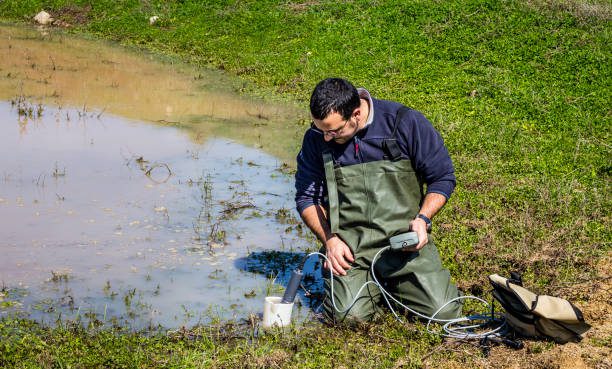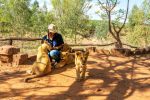| Wildlife Biologist Key Stats | |
|---|---|
| Avg. Salary / year | $77,920 |
| Avg. Pay / hour | $37.46 |
| Education | 4+ Years |
| Job Outlook | 8% |
| Total Employed | 16,920 |
People who love animals are not restricted to working as Veterinarians helping one pet at a time.
Instead they can choose to help animals as a whole by studying them in the wild or in a controlled environment such as a laboratory.
Wildlife Biologists lead a busy life spending their time studying animals, researching them in the field or working as educators.
They use their research and analytical skills and their vast knowledge of the animal kingdom to make the connection between the environment and its affect on the animals they study.
Wildlife Biologists know a lot about animals and their environments and study how the two affect one another.
They can work in the private sector or for governments and have several career options available to them.
Go to Page Section:
Education Requirements to Become a Wildlife Biologist
People who want to become a Wildlife Biologist should expect to focus on their studies for a few years before heading out into the job market because they need to have a vast knowledge on the animal kingdom as well as plants.
Those who want to become a Wildlife Biologist need at least a Bachelor of Science in Wildlife Biology or a similar track in order to work in the field.
On average, the typical Bachelor of Science degree takes four years to complete.
Wildlife Biologists who pursue more advanced degrees can expect more job opportunities.
Mandatory courses needed to acquire a Wildlife Biology degree include ecology, zoology and biology courses.
The subjects and information someone needs to learn in order to become a Wildlife Biologist includes recognizing the kinds of plants and animals that exist.
Potential Wildlife Biologists also need to learn the structure of plants and animals such as cells, body tissues and the functions they perform.
There are two paths a Wildlife Biologist can take: work in research or non research positions.
Someone in a non research position needs to have earned a degree in the biological sciences and in addition, needs credit hours in wildlife subjects, zoology and botany.
For a research position, a candidate should have earned a degree in Wildlife Biology, Botany or Zoology as well as have earned credits in Biological Science, Mathematics, Physical and Earth Sciences.
In addition, a strong background in Math is needed.
Completing courses in Algebra, Statistics, Calculus and Geometry fulfills this requirement.
Advanced degrees such as a Master’s or Doctor of Philosophy (Ph.D.) are more common in this field and provide more opportunities; most employers also prefer candidates with an advanced degree.
Wildlife Biologist Job Description
A Wildlife Biologist spends their time collecting and studying animals and analyzing the information they have found.
Time is spent outside in natural surroundings, in a lab studying animals under a microscope or in an office analyzing information.
Some typical tasks Wildlife Biologists perform include the following:
- They determine what species an animal belongs to by looking for specific characteristics.
- Perform animal dissections and analyze remains under a microscope.
- Determine whether animals under study are disease free.
- Examine live animals in their own environment or in a controlled one.
- Determine the effects an environment has on a species.
- Write articles and reports for scientific journals based on the studies and new information found.
Wildlife Biologists use an array of skills to research and analyze animal populations.
Wildlife Biologist Salary and Career Path
Wildlife Biologists can find open positions in the private sector, performing research for educational institutions or can also work for the government, state or federal.
Candidates can also look for positions within the many concentrations such as microbial ecology or land conservation.
Job opportunities for Wildlife Biologists and Zoologists are expected to grow until the end of the decade.
Beginning salary for a Wildlife Biologist is in the mid $50,000s and can go up to the low $90,000s for experienced workers.
The median salary for Wildlife Biologists is approximately $61,000.
Some who loves animals and nature may find that being a Wildlife Biologist is the perfect type of job for them.
Wildlife Biologists have a passion for nature and are committed to helping protect it so that animals can continue existing in their natural environment.
Conserving the natural habitats of the animals they study is a common mission so that future generations of these animals have the opportunity to continue to flourish and exist alongside the technological advances and a growing human population.
![]() The below information is based on the 2024 BLS national averages.
The below information is based on the 2024 BLS national averages.
National Average Salary
$77,920Average Salary by State
| State | Avg. Annual Salary |
|---|---|
| Alabama | $66,520 |
| Alaska | $86,060 |
| Arizona | $73,840 |
| Arkansas | $73,040 |
| California | $91,460 |
| Connecticut | $76,850 |
| Florida | $59,600 |
| Georgia | $70,690 |
| Hawaii | $84,060 |
| Idaho | $74,970 |
| Illinois | $80,240 |
| Indiana | $56,540 |
| Iowa | $82,770 |
| Kansas | $64,560 |
| Kentucky | $60,010 |
| Louisiana | $87,260 |
| Maine | $72,160 |
| Maryland | $95,790 |
| Massachusetts | $98,390 |
| Michigan | $79,550 |
| Minnesota | $72,870 |
| Mississippi | $94,330 |
| Missouri | $82,200 |
| Montana | $75,210 |
| Nebraska | $59,920 |
| Nevada | $64,230 |
| New Hampshire | $69,960 |
| New Jersey | $86,480 |
| New Mexico | $71,990 |
| North Carolina | $69,550 |
| North Dakota | $80,440 |
| Ohio | $74,870 |
| Oklahoma | $60,150 |
| Oregon | $84,550 |
| Pennsylvania | $72,360 |
| Rhode Island | $97,070 |
| South Carolina | $65,600 |
| South Dakota | $65,880 |
| Tennessee | $65,370 |
| Texas | $62,310 |
| Utah | $70,090 |
| Vermont | $77,050 |
| Virginia | $71,720 |
| Washington | $90,370 |
| West Virginia | $75,380 |
| Wisconsin | $68,840 |
| Wyoming | $70,200 |
| Puerto Rico | $50,670 |
The highest-paying state in this field is Massachusetts, with an average salary of $98,390.
Here are the five states with the highest salaries in the field:
* Employment conditions in your area may vary.
Frequently Asked Questions
What does a wildlife biologist do?
A wildlife biologist is a specialist who studies the biology, behavior, and habitats of a wide range of animals in the wild.
Wildlife biologists can work at community centers, zoos, consulting firms, environmental research facilities, colleges or for the state or federal government (U.S. Fish and Wildlife Service, for example).
The typical responsibilities of a wildlife biologist usually include studying ecosystems; conducting census projects and complex data analysis; saving endangered species; developing land and water use plans; trapping, tagging, and relocating animals for conservation purposes; studying wildlife disease transmission; writing research papers, and so on.
Of course, the duties of a wildlife biologist will differ, depending on the employer; however, the specialist would always be using his or her knowledge of wildlife and habitats to study and manage animal populations.
How much do wildlife biologists make?
On average, a wildlife biologist can make a little more than $51.000 per year in the United States.
In case you decide to follow this career path, you can expect to earn anywhere between $36.000 and $79.000 annually.
The salary would certainly depend on a variety of factors – your education and experience level, the employer, the location and so on.
The wildlife biologists that work in California, Colorado, and Washington, for example, have the highest average salaries.
An entry-level wildlife biologist can earn $15 per hour, while a specialist with plenty of experience will make $31 and more.
How much does it cost to become a wildlife biologist?
You would certainly need a bachelor’s degree in biology, environmental science, zoology, ecology or a related field, in order to become a wildlife biologist.
A year in a university can cost you anywhere between $8.000 and $45.000 (and more); the cost depends on a variety of factors (the books, supplies, and accommodation expenses are not included).
Most governmental and private employers will prefer you to have a master’s degree (over $11.000).
Aspiring wildlife biologists that are willing to teach at a university would need to hold a doctorate degree, in most cases (around $20.000 per year).
In the future, you can become a certified wildlife biologist ($115-$155).
What is the demand for wildlife biologists?
Between 2016 and 2026, the wildlife biologist job market is expected to grow by 8%, according to the Bureau of Labor Statistics.
That is a little faster than the national average for all occupations in the United States.
The public will become more interested in eliminating the hazards facing the environment and the living organisms of our planet in the near future.
The candidates that hold a master’s or doctorate degree will have better job prospects.
How long does it take to become a wildlife biologist?
It will take you 4 years to obtain a bachelor’s degree and another 2 years to earn a master’s degree.
A doctorate degree typically takes 5-6 years to acquire.
Volunteering at wildlife conservations and other organizations can be helpful.
To become a certified wildlife biologist, you would need to have at least 5 years of professional experience and meet the educational requirements.














